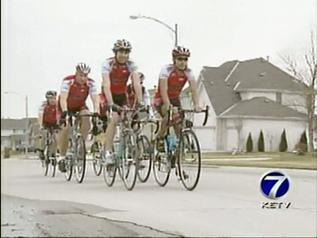 |
Team Kaos president Marco Vasquez drinks chocolate milk after a long ride. |
Roberts Dairy and Team Kaos, an Omaha-based amateur bicycle racing team sponsored by UNMC, The Nebraska Medical Center and University Physicians, performed their own unscientific research based on the results of a study published in the International Journal of Sport Nutrition and Exercise Metabolism. In that study, nine cyclists at the Indiana University in Bloomington drank lowfat chocolate milk after an intense period of exercise. They were able to work out longer — and with more power — during a second workout, compared to athletes who drank commercial sports beverages.
For its unscientific study, Roberts Dairy supplied seven Team Kaos cyclists with a week’s supply of its Vitamin D Whole Chocolate Milk in 16-oz. bottles. (Note: The original Indiana University study was conducted with lowfat chocolate milk.) Each cyclist replaced chocolate milk with their regular recovery drink as they trained and raced in Omaha and Lincoln from March 4 to March 12.
Team Kaos president Marco Vasquez, a 15th place finisher at the USA Cycling Masters Road National Championships last summer, said he drank one bottle of Roberts Chocolate Milk when he did not anticipate eating anything else for more than a couple of hours. On days when he would be eating sooner, he drank half a bottle (8-oz.).
“On the days that I worked out and the Roberts Chocolate Milk was my only meal, I felt no soreness and it compared to my usual recovery drink,” Vasquez said. “When comparing the caloric contents, protein to carbohydrate ratio and protein contents, it is surprising to see how close it (chocolate milk) is to a formulated recovery drink.”
Vasquez said the revelation that chocolate milk is a viable recovery drink could change the way he approaches a long training ride.
 “Instead of having to pack a recovery drink for a ride, I can stop in at any convenience store and get a bottle of chocolate milk,” Vasquez said.
“Instead of having to pack a recovery drink for a ride, I can stop in at any convenience store and get a bottle of chocolate milk,” Vasquez said.
The cost per serving is comparable or less, Vasquez said, noting that his normal recovery drink costs close to $2 per serving.
Team Kaos’ Tim Farnham finished first and third in training races in Lincoln on the first weekend of the study, then finished third a week later in one of the same races. The University of Nebraska-Lincoln student said he “wasn’t quite sure” if the Roberts Dairy Chocolate Milk had any performance benefits for him.
“But it sure tasted good, Farnham said. “The Roberts Whole Chocolate Milk was a little thick. I think it was best when warmed up after a cold ride.”
Mark Brackenbury, who finished eighth in a racing event in Lawrence, Kan., on March 11, agreed on the good taste and said he felt as least as good as when he used his normal protein recovery drink.
“With such a short testing time it’s hard to really judge it’s effectiveness, but I’d say it’s an effective recovery drink just based on the carbohydrate and protein numbers on the label,” he said.
In addition to its ideal combination of carbohydrates and protein, flavored milk like Roberts Chocolate Milk contains seven other essential nutrients that are important for an athlete’s health — including bone-building calcium. According to the 2005 Dietary Guidelines and MyPyramid recommendations, Americans of all fitness levels should include at least three servings of lowfat or fat free milk or milk products in their diet every day.